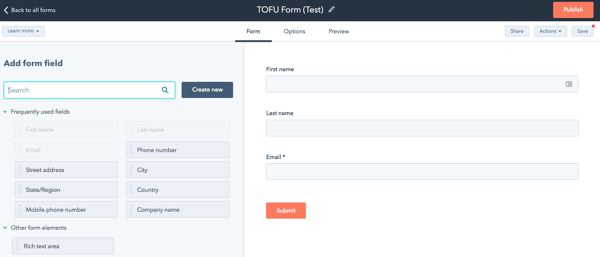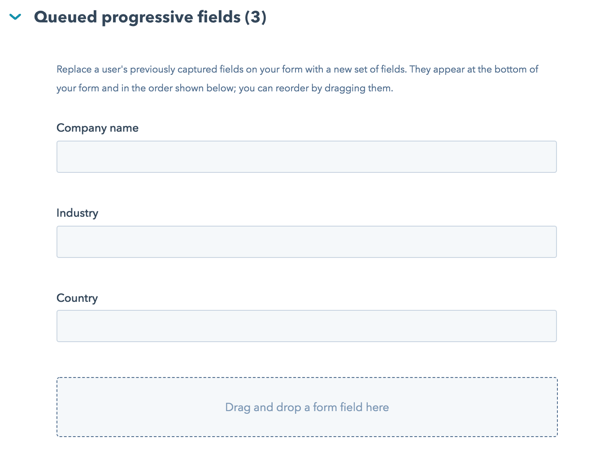The other day, I filled out a form to seek information about potential health insurance options. Nearly a week later, I've received 74 phone calls from various providers.
What started as an honest pursuit of knowledge became a nightmare.
During the first few calls, before I could get a single word out besides "Hello?" an eager sales representative would interrupt with, "I heard you're looking for a new health insurance provider!"
We've all had these types of experiences before. They're frustrating, especially to business owners and marketers, because we know better. We know that to gain a customer's trust, we need to try to help our customer, not only aggressively sell. Because as Seth Godin puts it, "treating people with respect is the best way to earn their attention."
However, you still need to collect information to improve your customer data. So how do you gather valuable insights about potential customers without irritating them? With a practice called progressive profiling.
What Is Progressive Profiling?
Imagine that you're meeting someone for the first time. You introduce yourself, shake hands, and ask for their name. After that, it takes awhile to get to know them. Collecting information from customers is no different. With progressive profiling, we can extract data from customers little by little, instead of asking for too much information upfront.
Progressive profiling helps us to capture information without overwhelming leads with too many questions at once or asking for information they aren't yet ready and comfortable to provide.
So, for TOFU prospects, we want to ask for the bare minimum amount of information required when trying to convert them into a lead. But, over time, we may need more information to qualify them or move them through the sales process.
Progressive profiling makes this a gradual process, allowing the lead to share their data at their own pace.
It works well because:
- Perceived as low-risk.
- Lowers the barrier to conversion, as asking for too much information may scare off the lead.
- Sales won't waste time on leads that aren't ready to buy.
- Sales can prioritize the most qualified, motivated leads.
It's a win-win for everyone involved. Motivated leads will move through your sales funnel faster, and anyone who wants to take their time won't get scared off. And over time, you can improve the quality of your lead data. There are a few ways progressive profiling accomplishes this.
Collects The Data You Need To Sell
When you use progressive profiling strategically, you can get all of the information you need to sell and qualify. So before setting up forms to conduct progressive profiling, you need to determine what types of information your team requires to identify potential customers and sell to them.
To decide what type of information this is, consider:
- The aspects of customer behaviors, personality, or preferences would be useful to know, or what data would help you understand your customer more.
- Demographics and characteristics of your ideal customers, such as their preferred location, company size, title, or annual revenue.
- The characteristics of leads you do not want to attract.
Try consulting with your marketing and sales team to agree on what customer data you should collect. You can get their feedback about the information they’re missing, and determine what additional information could improve sales calls, pitches, and marketing collateral.
Maintains Customer Data Quality
As you implement progressive profiling, you’ll accumulate a lot of information that will feed right into your contact database. After determining the information you’ll ask from leads, check and make sure every property is in HubSpot. HubSpot already has a lot to choose from, including:
- First Name
- Last Name
- Email
- Phone Number
- Company Name
- Street Address
- City
- State
- Country
- Phone Number
Depending on your goals, there may be additional custom properties you need to add. It’s easy to set these properties up, using HubSpot best practices for guidance.
Builds Trust With Leads
Let's go back to my health insurance fiasco. When I filled out that form, I provided my phone number. However, neither the landing page or form stated that I would receive phone calls. As a result, those constant calls eroded the trust I could have had with any of those providers. It was too soon to ask for a phone number, and a follow-up sales call since I wasn't prepared to buy.
That's why it's so important to ask the right questions, at the most appropriate time. Decide what makes sense to ask first by matching them with the right buyer's journey stage.
TOFU / Top Of The Funnel
When customers first try to solve a problem, they conduct a lot of research, such as watching YouTube videos, scouring Reddit and Quora, or Googling aspects of their challenge. Since they’re solely looking for information, appropriate form fields for any gated content should be introductory, such as:
- First Name
- Last Name
- Email Address
MOFU / Middle of the Funnel
The form fields for this stage depend on your criteria for a qualified marketing lead. Marketing qualified leads match the requirements to be a customer and are likely to become one, based on their behavior and demographics. Standard form fields at this stage can include:
- Company
- Industry
- Team Size
- Company URL
Another consideration for MOFU forms is information that could disqualify a lead. Figuring out the questions that can help you exclude leads is just as important as asking the questions that will. Here at Lean Labs, for example, we only work with companies based in the United States. That’s one of our set criteria. After anyone becomes a TOFU lead, on their next engagement, we’ll want to know where their office location. We want to ask this on the form, rather than relying on their IP address, in case they work remotely or out of office.
This qualifying question helps us weed out companies that aren't a match. It saves both parties time. They won't sit on a 30-minute sales call, only to realize they're not a match. We don’t want to waste anyone’s time. It all goes back to what Seth Godin said, about respect.
BOFU / Bottom of the Funnel
At the BOFU level, you know the customer's interest. They've given signals that they're ready to move forward, and if you ask them to sign up for a demo, or a trial, they're going to say yes. So at the BOFU - or Bottom of the Funnel stage, ask the questions that lead them to your offer.
If it's a free trial, and a sales team member needs to set that up, ask for their phone number. If the offer requires a meeting, provide the ability to set a time on your calendar.
Personalizes The Customer Experience
Since form fields will populate based on the lead's status, potential customers won't get asked for information they're not ready to give. However, when creating a HubSpot Smart Form, still set preliminary TOFU form fields first, such as First Name, Last Name, and Email Address.
The form may look like this:
After you set those fields, you can add form fields to the section below that, called “Queued Progressive Fields.” This section is where we’ll possibly add additional TOFU fields or MOFU form fields. We can add our selected form fields to the queued fields, like this:
This way, when HubSpot already has preliminary information (First Name, Last Name, and Email), the queued form fields will automatically populate in their place. For additional personalization, HubSpot also offers smart website content you can tailor to where a prospect is in the buying process.
Optimize Progressive Profiling Over Time
Progressive profiling takes practice. It'll take some time and optimization to organize and improve your customer data. So in the meantime, make sure your team puts in their best effort to keep information organized and updated, use smart forms, and learn from your mistakes.
If you're ready to set up progressive profiling and forms in HubSpot, this article shows you how to do it. If you read through this entire article and feel a little lost, here are some basics about the buyer's journey that may help. And if you've never used HubSpot, or interested in learning more about the platform, check out our savings guide.
We've worked with a ton of clients and successfully on-boarded them to HubSpot, helping them implement tactics such as progressive profiling to attract and retain qualified, hungry customers. With our guide, you can save up to 60% on HubSpot during your first year.